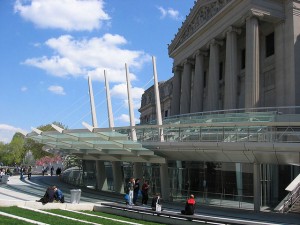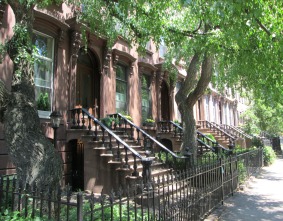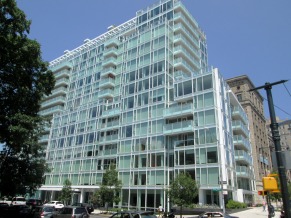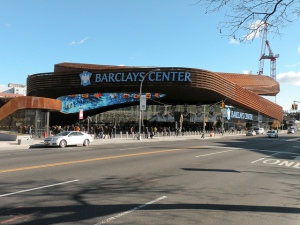The Prospect Heights area of Brooklyn is a blend of the old and the new. This can be seen in the buildings that make up the neighborhood, from older town houses and classic Brooklyn brownstones, to new high-rise construction. Many notable locations can be found in Prospect Heights including the Brooklyn Museum, Prospect Park, the Brooklyn Botanical Garden, the main branch of the Brooklyn Public Library and, most recently, the Barclays Center.
The history of Prospect Heights is a rich one. In August of 1776, part of the Battle of Brooklyn, a significant battle of the Revolutionary War, was fought in Prospect Heights and the surrounding areas. This battle resulted in the defeat of the American forces, however, due to bad weather, many American soldiers were able to flee to Manhattan and escape capture or death. Nearly one hundred years later saw the grand opening of Prospect Park to the public in 1867. The end of the 19th century was a significant time in Prospect Heights development, with the Brooklyn Museum opening in 1897, then known as the Brooklyn Institute of Arts and Sciences, and the Brooklyn Children’s Museum, which is the world’s first children’s museum, following suit in 1899. Both of these institutions still exist and thrive today. The majority of houses in Prospect Heights were constructed after Prospect Park was opened to the public. Residents of mostly Jewish, Italian, and Irish descent moved into the neighborhood. It was a middle class area, with most residents working in near-by factories and as shop owners. The neighborhood continued to flourish at the beginning of the 20th Century, with Ebbets Field, home to the Brooklyn Dodgers, being built in 1913.
![By Boston Public Library (Flickr: Ebbets Field, Brooklyn. N. Y.) [Public domain], via Wikimedia Commons](https://researchnychistory.files.wordpress.com/2015/04/ebbets_field_brooklyn-_ny-1.jpg?w=300&h=193)
By Boston Public Library (Flickr: Ebbets Field, Brooklyn. N. Y.) [Public domain], via Wikimedia Commons
The’90’s and the first decade of the 21st Century have been a time of great change for Prospect Heights as it has become a more desirable place to live. This change can be seen in the neighborhood’s real estate market. Although the vast majority of houses in Prospect Heights were built before 1940, there has been a significant increase in new houses being constructed since 2000. The prices of owning and renting home since the 1980’s have steadily increased, with 2 or 3 bedroom condos and brownstones now commonly going for over 1 million dollars. A one bedroom condo can easily go for over $500,000 and the median price of a home is $592 per square foot. In 2008, renters paid a median amount of $1,473 a month. Due to new construction and changes, residents of the neighborhood sought to make an area of Prospect Heights a historic district. It was designated a historic district by the Landmarks Preservation Commission of June 23, 2009. Information about the Prospect Heights historic district can be found here .
These changes have also resulted in a huge drop in crime. Over the past 20 years the major crime rate has dropped by over 80 percent. 40 percent of this drop occurred in the last decade. The recent change that Prospect Heights has seen has also resulted in changes in the public schools of the area. In 2006, the number of elementary and middle school students who received a proficient score on the state wide tests were 42.8% on the math exam and 43% on the English Language Arts exam. By 2010 these scores had jumped to 76.2% and 65.1 % respectively.
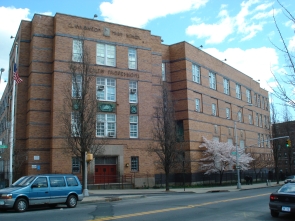
“Clara Barton High School, Brooklyn” by One dead president – Own work. Licensed under GFDL via Wikimedia Commons
The neighborhood has a population of around 18,000, with the majority of the residents being black and white. Prospect Heights residents are a mix of families and younger singles. The median age of both male and female residents of Prospect Heights is around 35 years old. 28.4 % of Prospect Heights residents are married, with 33% of these married couples having children. The neighborhood has healthy amount of restaurants, bars, shops, and family-oriented activities to cater to its diverse residents.
A good depiction of the diversity of the neighborhood can be seen in the following statistics: 40.5 % of Prospect Heights residents were born in New York state, 35.8% were born in a different state, and 20.9% are foreign born. A good portion of foreign born residents are from the Caribbean. Significantly, the median year that owners moved in to their Prospect Heights home is 1999, and the median year for renters 2004. This demonstrates the fairly recent influx of people moving into the neighborhood over the past 2 decades, although there are still a good number of “old-timers” in the neighborhood.
The percentage of Prospect Heights residents with bachelor’s degrees, graduate degrees, and post-graduate degrees are significantly higher than those found elsewhere in New York.The percentage of resident living below poverty level is 10.8%, lower than the New York average of 16 %. Similarly, the median household income was $82,710 in 2008, higher than the New York average of $55, 256. This can be viewed in contrast to the 1980 Census data, which reports Prospect Height’s household income level as well below the Brooklyn average, showing the immense change the neighborhood has seen over the past three decades.
Sources
De Avila, J. (2010, December). Prospect Heights: Slope appeal with edge. The Wall Street Journal. Retrieved from http://www.wsj.com/articles/SB10001424052748704457604576011492254995096
Goode, K. (n.d). Brooklyn history- an overview. Retrieved from http://brooklyn.about.com/od/historicbrooklyn/a/History.htm
Jackson, K. T. (Ed.). (2004). Neighborhoods of Brooklyn. (2nd ed.). Yale University Press.
(n.d). Prospect Heights neighborhood in Brooklyn, New York (NY), 11238, 11217, detailed profile. Retrieved from http://www.city-data.com/neighborhood/Prospect-Heights-Brooklyn-NY.html
Plambeck, J. (2011, April 14). Tucked between past and future in Brooklyn. The New York Times. Retrieved from http://www.nytimes.com/2011/04/17/realestate/17living.html?_r=0
-Amelia
